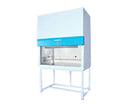Description
BIOSAFETY CABINETS CLASS II A2
- The range of Class II Biosafety Cabinets is designed for product, personnel, and environmental protection.
- They are suitable for general microbiological work with agents assigned to biosafety levels 1,2 or 3.
- These Biological Safety Cabinets are ideally used in hospitals, clinical research, life science, and pharmaceutical laboratories.
- These units come with a motorized sliding shattered-proof glass view screen, base stand, removable work tray, supply filter, and HEPA filters.
- These Class II biological safety cabinets can be either exhausted back into the room or outside the room.
Technical Details of The Product - CLICK THE BELOW LINK
Biological Safety Cabinet with Counter-Balanced Sash
Biosafety cabinets (BSCs) are essential pieces of equipment used in laboratories, research facilities, and healthcare settings to provide a controlled and safe environment for handling hazardous materials. They offer several benefits to ensure the protection of personnel, the environment, and the integrity of experiments. Here are some key benefits of biosafety cabinets:
-
Personnel Protection: One of the primary advantages of biosafety cabinets is the protection they provide to personnel working with hazardous materials. BSCs are designed to contain and control harmful aerosols, particles, and pathogens, preventing their escape into the laboratory and minimizing the risk of exposure to laboratory personnel. The airflow within the cabinet creates a barrier that protects the user from inhaling or coming into direct contact with hazardous substances.
-
Product/Experiment Protection: Biosafety cabinets create a sterile and controlled environment, safeguarding the integrity of experiments, samples, and products. They prevent contamination of sensitive materials by providing a physical barrier between the work area and the external environment. BSCs are particularly important in research involving cell cultures, genetic manipulations, and other delicate experiments that require a sterile environment.
-
Environmental Protection: BSCs are designed with high-efficiency particulate air (HEPA) filters that capture and trap airborne particles, microorganisms, and other contaminants. These filters help prevent the release of hazardous materials into the surrounding environment, ensuring the laboratory space remains clean and safe. They also minimize the potential for cross-contamination between experiments or samples.
-
Regulatory Compliance: Biosafety cabinets play a crucial role in ensuring compliance with regulatory guidelines and standards. Various regulatory agencies, such as the Centers for Disease Control and Prevention (CDC) and the Occupational Safety and Health Administration (OSHA), provide specific requirements for handling hazardous materials. Using certified BSCs helps laboratories and research facilities meet these guidelines, ensuring a safe working environment and adherence to legal and regulatory requirements.
-
Versatility: BSCs come in different classes and configurations, allowing users to choose the appropriate cabinet based on their specific needs. There are Class I, Class II, and Class III cabinets, each offering different levels of protection and functionality. This versatility enables users to select the most suitable BSC for their particular application, whether it involves handling volatile chemicals, biological agents, or sterile materials.
-
Ease of Use and Maintenance: Biosafety cabinets are designed for user convenience and ease of maintenance. They often include features such as adjustable working heights, ergonomic design, and intuitive controls, making them comfortable to operate. Additionally, BSCs typically have alarms or indicators to alert users to issues such as filter replacement or airflow problems, ensuring that the cabinet is properly maintained and functioning optimally.
-
Containment and Decontamination: BSCs provide a contained workspace that facilitates proper containment and disposal of hazardous materials. They often have features like sealed work surfaces, glove ports, and waste collection systems, making it easier to handle and dispose of hazardous substances safely. Furthermore, many BSCs have decontamination systems, such as ultraviolet (UV) light or hydrogen peroxide gas, to sanitize the interior workspace and ensure cleanliness between uses.
It's important to note that biosafety cabinets should be selected, installed, and used in accordance with the specific guidelines and standards applicable to the intended application and level of biological or chemical risk. Regular maintenance, certification, and appropriate training for users are crucial to ensure the ongoing effectiveness and safety of biosafety cabinets.


